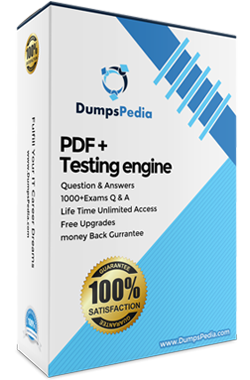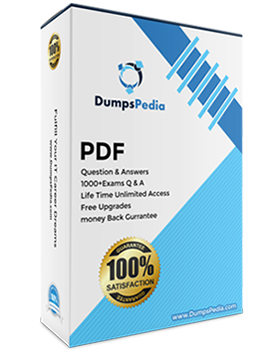
Adobe Marketo Engage Architect Practice Questions
The most impressive hallmark of Dumpspedia’s AD0-E556 dumps practice exam questions answers is that they have been prepared by the Adobe industry experts who have deep exposure of the actual Adobe Marketo Engage exam requirements. Our experts are also familiar with the Adobe Marketo Engage Architect exam takers’ requirements.
AD0-E556 Adobe Exam Dumps
Once you complete the basic preparation for Adobe Marketo Engage Architect exam, you need to revise the Adobe syllabus and make sure that you are able to answer real AD0-E556 exam questions. For that purpose, We offers you a series of Adobe Marketo Engage practice tests that are devised on the pattern of the real exam.
Free of Charge Regular Updates
Once you make a purchase, you receive regular Adobe Marketo Engage Architect updates from the company on your upcoming exam. It is to keep you informed on the changes in Adobe AD0-E556 dumps, exam format and policy (if any) as well in time.
100% Money Back Guarantee of Success
The excellent AD0-E556 study material guarantees you a brilliant success in Adobe exam in first attempt. Our money back guarantee is the best evidence of its confidence on the effectiveness of its Adobe Marketo Engage Architect practice exam dumps.
24/7 Customer Care
The efficient Adobe online team is always ready to guide you and answer your Adobe Marketo Engage related queries promptly.
Free AD0-E556 Demo
Our AD0-E556 practice questions comes with a free Adobe Marketo Engage Architect demo. You can download it on your PC to compare the quality of other Adobe product with any other available Adobe Marketo Engage source with you.
Related Certification Exams
| AD0-E555 - Adobe Marketo Engage Professional | Buy Now |
| AD0-E559 - Adobe Marketo Engage Business Practitioner Expert | Buy Now |
| AD0-E560 - Adobe Marketo Engage Architect Master | Available Soon |
AD0-E556 PDF vs Testing Engine










10
Customers Passed
Adobe AD0-E556
93%
Average Score In Real
Exam At Testing Centre
92%
Questions came word by
word from this dump
Adobe Marketo Engage Architect Questions and Answers
Refer to the case study.
UNICORN FINTECH COMPANY PROFILE
Unicorn Fintech is a mobile-only financial-servicesstartup created by a consortium of consumer banks to resell savings, checking, loan, transfer/remittance, and other services from a secure smartphone app. The company is venture-funded, and plans to reach profitability before a planned IPO in two years.
Business issues and requirements
Marketing is responsible for acquiring new customers 0 through online, television advertising, and email campaigns, and for cross-selling new services to customers through IM, email, and in-app campaigns. Evaluating the success of these campaigns has been a persistent problem: although the company can track revenue by product line, it can't attribute those revenues to campaigns: for example, did a new loan come from onboarding a new customer, or by cross-selling a savings-account customer? Marketing currently uses
crude, manual tools and guesswork to evaluate the quality and lifespan of new leads, and even the deliverability of emails in its external campaigns. As a result, the department can't allocate spending to the most productive campaigns, or decide how much different touchpoints in multi-stage campaigns contribute to revenue. Operational processes to connect lead data to CRM and other databases are entirely manual.
Staffing and leadership
Unicorn has fewer than 200 employees, and roles aren't always defined in traditional ways. Since customer acquisition and cross-selling are primarily through electronic channels, Marketing and IT roles especially often overlap. The traditional Sales role falls entirely to Marketing, and IT is responsible for the Salesforce CRM system, Google Analytics, and a handful of third-party integrations. The CMO and CIO work closely together on most initiatives, and budgets are typically project-driven rather than fixed annually. Individual contributors to Marketing campaigns include the Marketing Operations Manager, responsible for lead scoring and analytics. Key IT contacts include the CRM Administrator and Web Developer. Incidental contributors are the Corporate Attorney, who signs off on opt-in/out and DMARC policies.
Revenue sources
Unicorn earns commissions on financial services delivered by the banking consortium through its apps, including fixed finders' fees for what the company calls "skips"-customers who initially engage with Unicorn, but then "skip" to receive services directly from a consortium bank. Unicorn needs to attribute revenue from these customers to its own campaigns; currently, it's impossible to attribute ROI to individual campaigns, or provide documentation to claim commissions on "skips."
Current and aspirational marketing technology
Current Marketing technology consists of Marketable,an open-source lead management solution supported by a set of spreadsheets and scripts developed in-house. Marketable offers lead tracking and source attribution, but not multi-touch source attribution. Unicorn Fintech Marketing has difficulty linking the different stages of customer campaign journeys, and relies on scripts to translate Marketable's "sales alerts" into next steps it could use in multi-touch campaigns. IT has worked out scripts to input Marketable qualified leads into Salesforce, but the system is brittle and often requires manual intervention.
Current campaign management processes
A typical email campaign:
• Addresses a purchased (for customer acquisition) or0 in-house (for cross-sell) list. Purchased lists range from 300,000 to 1.5 million addresses
• Is sent from multiple data centers in the US and Canada
• Includes an "unsubscribe" opt-out below the message
• Is static; there are no formula fields
• Uses no deliverability authentication, nor integration 0 with any email management platform.
All campaigns to date direct respondents to a single 0 landing page with the company's "all markets" message. More sophisticated targeting is a high priority.
Current lead management and attribution
Unicorn's lead-management process follows
Marketable's "out of the box" defaults: lead evaluation levels 1 through 3, lifecycle stages "unqualified" and "qualified." The qualification processes are manual, and highly subjective: Marketing staff classify leads according to prospect email responses, including free-form comments. "Sales" followup is by email forms prompting higher levels of engagement. The company intends to phase out Marketable and replace spreadsheets and scripts with native features of whatever solution set it adopts.
Attribution processes are binary: response to a campaign email or web visit is rated a success if it results in a sale: there is no success rating assigned to TV ads that result in web visits, for example. Cost are not allocated to individual campaigns.
The Marketing department plans to expand outreach to social media (Facebook, Twitter, Instagram, in-house and third-party financial blogs), and wants to make sure it can assess the ROI of these channels, and the overall social media program.
Current governance processes
Currently, the Marketing department assigns content development and campaign management duties to team members on a campaign-by-campaign basis. All team members (and IT) have access to all assets and tools, which sometimes leads to duplication and conflicts. The CMO realizes that a more specialization will be necessary to support the social media campaigns, but hasn't decided on the optimal organizational model.
Input of qualified leads from Marketable into
Salesforce is by manual cut-and-paste, assisted by scripts; inconsistency of input practices across Marketing team members is a known problem; individual members have their own "go-to" fields: where one member might check "TV ad" as Lead Source, another would put that in the comments field.
CMO
The CMO's most important concerns are:
• The current solution has too many manual steps to scale with anticipated growth
• Without more sophisticated attribution, the company will overinvest in less productive campaigns, and underinvest in better ones
• In general, analytics integrations are manual, slow, and unreliable
• The current system completely misses "skips"-customers switching from the Unicorn app to consortium banks-an important source of revenue
• Documenting the value of Unicorn's Marketing processes is essential to the success of the planned IPO, and millions of dollars in stock valuation hangs in the balance.
CIO
The CIO is concerned primarily with:
• The amount of time his team spends patching up Marketing campaigns and CRM data transfers, at the expense of other, critical initiatives
• Quality and reliability of the Analytics information his team provides to Marketing
MARKETING STAFF
Marketing Operations staff concerns:
• Campaigns require so much work that they can't run as many of them as they need to
• Multi-touch cross-selling campaigns (for example, savings accounts to loans) with excellent margins, but no way to know which campaign touches perform best
• Getting swamped with manual record-keeping; for example, spreadsheet mistakes take hours to find and
fix
• Poor integration with third-party tools for preparing, sending, and evaluating campaign materials, for
Example.
o Webhook not firing,
o Reaching API limit
o Synchronization errors with third-party tools and Salesforce
• Inadequate number of lead stages and qualification levels, making it difficult to evaluate lead value, especially in multi-touch campaigns
Despite the absence of an external Sales team,
Marketing Operations would like to improve the granularity of their lead tracking, including both lifecycle stages and quality levels, with "no score" and negative levels.
The social media team at Unicorn Fintech has been running paid search, paid social, and retargeting ads for the past year. Each of these is an Adobe Marketo Engage program channel and is set up to capture program member success and cost. The newly formed Account Based Marketing team (ABM) also wants to run paid social and retargeting ads but has their own budget. They want to report on their ABM efforts and ROI of their specific programs separate from the social media team. The social media team wants to be able to see how all campaigns are performing as well as easily separate the ABM efforts.
How should the Marketo Engage Architect set up the program structure to achieve these reporting goals?
A marketer is in charge of marketing campaigns for a company that creates customized vinyl figurines. The marketer is launching a multi-channel campaign that will include nurture, webinars, paid social ads, virtual events, and more. The marketer creates a nurture email program that consists of a series of six emails to be sent once a week and wants to understand the impact. The target audience will be put through many campaigns.
When reporting on effectiveness or ineffectiveness of an email nurture, which two valid metrics should the marketer utilize to decide what to do next? (Choose two.)
A large global company hires a media agency to run their paid social campaigns. They use a standardized UTM structure to track paid activities, which will allow them to differentiate paid efforts versus organic efforts. For example, UTM-source=paid social, UTM-medium=facebook, UTM-campaign:=B2B-social, UTM-content=Definitive-guide-to-paid-social. Cost will be added to the Adobe Marketo Engage programs on a monthly basis. The same assets will be used across campaigns and social platforms (Twitter, Facebook, Linkedln).
Which Marketo Engage program structure will allow the company to determine paid social effectiveness and ROI?




